01 October 2020
By Maynard Paton
I trust your shares have performed well during the last three months.
A quick summary of my portfolio’s third-quarter and year-to-date progress:
- Q3 gain: +4.4%*
- Q3 trades: None.
- YTD gain: +3.4%* (FTSE 100: -20.2%**)
- YTD winners/losers: 4 winners vs 8 losers
(*Performance calculated using quoted bid prices and includes all dealing costs, withholding taxes, broker-account fees and paid dividends. **Includes reinvested dividends.)
The news from my shares during Q3 was generally satisfactory in the circumstances.
Among my holdings releasing results during the quarter, two reported lockdown-lowered profits that were complemented with promising director recovery talk. One holding meanwhile lifted its dividend 11% and another announced a very unexpected special payout.
After making no trades during the second quarter, I did not buy or sell during this latest quarter either. Never before since starting this blog during 2015 have I refrained from adjusting my portfolio for six months.
How companies will fare as the pandemic continues is still impossible to predict. I remain 25% in cash and hope a few obvious bargains may one day appear.
I will now outline what happened within my portfolio during July, August and September. (Please click here to read all of my previous quarterly round-ups). I will then explain how I have earned returns of up to 85% from boring old dividends.
Contents
- Disclosure
- Q3 share trades
- Q3 portfolio news
- Q3 portfolio returns
- Up to 85% returns from boring old dividends
Disclosure
Maynard owns shares in Andrews Sykes, Bioventix, City of London Investment, Mincon, Mountview Estates, S&U, System1, Tasty, FW Thorpe, Tristel and M Winkworth. This blog post contains SharePad affiliate links.
Q3 share trades
None.
Q3 portfolio news
As usual I have kept an eye on all of my portfolio holdings. The Q3 developments are summarised below:
- An 11% dividend lift at City of London Investment;
- A very acceptable lockdown performance from M Winkworth;
- Generally satisfactory half-year figures from Mincon;
- Welcome resilient results plus a very unexpected special dividend from Andrews Sykes;
- Lower full-year earnings offset by a 2% dividend advance at FW Thorpe;
- An upbeat-but-not-truly-gangbusters update from Tristel;
- Nothing from Bioventix, Mountview Estates and System1.
Q3 portfolio returns
The chart below compares my portfolio’s weekly 2020 progress (in green) to that of the FTSE 100 total return index (in blue):
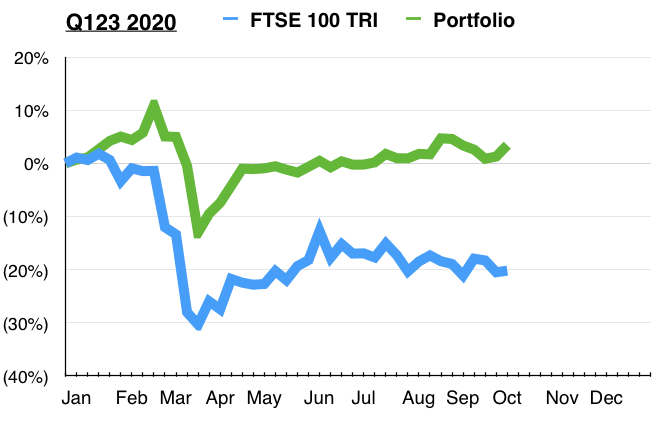
The next chart shows the total return (that is, the capital gain/loss plus dividends received) each holding has produced for me year to date:
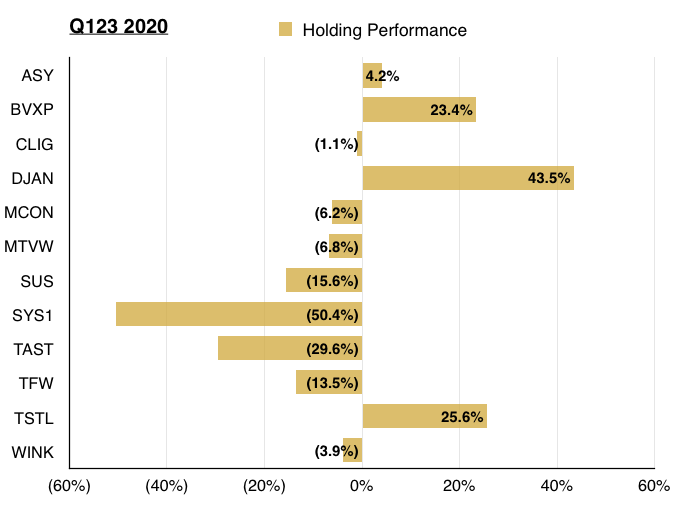
The chart below shows each holding’s contribution towards my overall 3.4% gain:
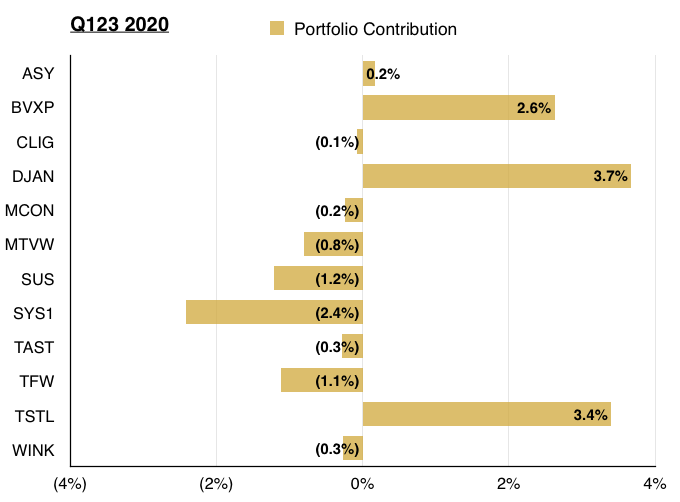
And this chart shows my portfolio weightings at the end of Q3:
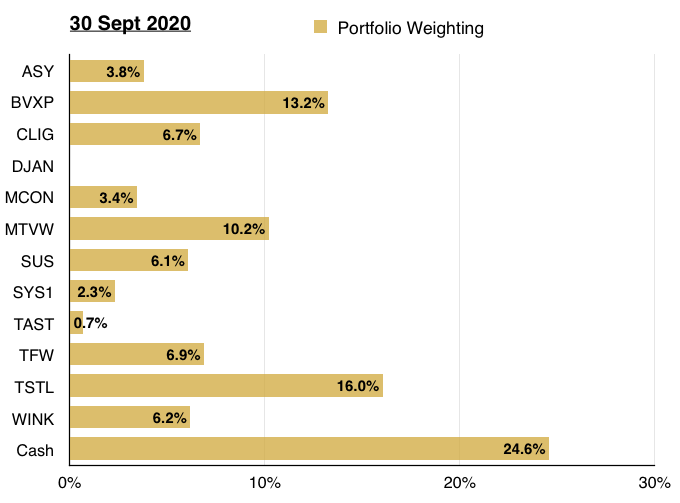
Enjoy my blog posts through an occasional email newsletter. Click here for details.
Up to 85% returns from boring old dividends
Three months ago I outlined how I 10-bagged my money on Tristel.
The write-up proved immensely popular. Nothing gets my page views motoring quite like a headline about huge gains. Comments flooded in as readers recalled their own 10-baggers. Even tracker-happy Monevator found the article worthwhile:
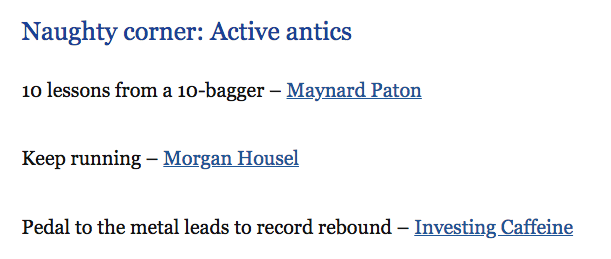
This article will not be so popular because I am writing about boring old dividends. Why bother with shares that pay 5% yields but their prices that go nowhere…
…when you can go for growth and look for capital gains of 100%, 200%, 300% or more?
I am not even sure whether anyone still invests for income. Most private investors now seem hooked on highly rated ‘quality’ stocks (offering minimal yields) or Covid-crippled names with major recovery ‘potential’ (offering no yields).
Even that (former) star of the equity-income sector — Neil Woodford — gave up on dividends when he swapped traditional blue chips for start-ups involved in cold fusion and artificial intelligence.
A surprisingly useful boost
If you are still with me, then dividends can provide a surprisingly useful boost to your overall returns if you hold on for long enough.
My best income share has returned 85% of my initial purchase price through dividends and another 18 months should see the entire investment recouped by payouts alone.
Let’s take a closer look at my dividend returns.
My portfolio dividend study
To keep things simple, I have limited this study to my current 11 holdings and determined their ‘buy prices’ from my very first purchase of each share.
I have not accounted for subsequent buys and sells of each holding, so the calculations are not a precise reflection of my dividend returns. But I am sure the overall picture is close enough. I have also used SharePad’s comprehensive database for the dividend stats:
This table lists the initial buy prices for my holdings, and the total dividends subsequently received:
| Holding | First bought | Initial price paid (p) | Dividends received (p) |
| Andrews Sykes | May 2013 | 229 | 195 |
| Bioventix | August 2016 | 1,144 | 343 |
| City of London Inv | August 2011 | 355 | 239 |
| Mincon | February 2015 | 44 | 11 |
| Mountview Estates | November 2011 | 4,164 | 2,525 |
| S & U | January 2017 | 2,056 | 410 |
| System1 | March 2016 | 311 | 65 |
| Tasty | December 2011 | 49 | - |
| FW Thorpe | October 2010 | 68 | 39 |
| Tristel | December 2013 | 42 | 30 |
| M Winkworth | June 2011 | 89 | 61 |
And this chart shows the associated percentage returns:
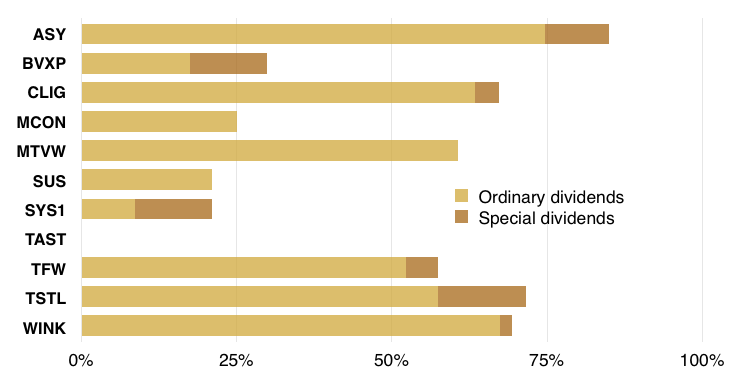
Sure, we are not talking 10-bagger gains here, but a few of my shares are not far away from repaying my initial purchase price entirely through dividends.
Andrews Sykes is my top income share, having already paid dividends representing 85% of my 2013 buy price. Assuming the group’s trailing ordinary dividend is held at 22.4p per share, another 18 months ought to see 100% reached.
Although Andrews Sykes’ dividend has not advanced since 2014, my initial 10% yield always gave the investment a very healthy starting income.
Tristel might challenge Andrews Sykes to be first to repay my initial investment through dividends. So far the payouts I have received represent 72% of my entry price.
Tristel is a completely different ‘dividend investment’ to Sykes. The trailing yield at the time of my 2013 purchase was only 1%, but the payout has since soared an amazing 14-fold.
I calculate Tristel’s present dividend will get me to the magic 100% repayment within two years.
Those fighting for bronze in the race to 100% are City of London Investment, Mountview Estates, FW Thorpe and M Winkworth.
Assuming their payouts remain unchanged, this group will probably take until 2024 or 2025 to repay my initial investment. I should add I first bought these four shares during 2010 or 2011, so they do have the advantage of tenure versus my other holdings.
Special dividends have also bolstered by returns. Until this study I had not realised I have collected special payouts from seven of my shares. Bioventix has actually paid me three specials while System1, FW Thorpe and Tristel have each paid two.
***ShareScope New Subscriber Special Offer***
Readers of my blog can enjoy a 20% first-year discount! Click here for details >>
Dividends versus capital gains
While dividends have provided handy returns for my portfolio, the figures are admittedly dwarfed by the associated share-price movements.
This chart emphasises the difference between the dividend payments and capital gains:
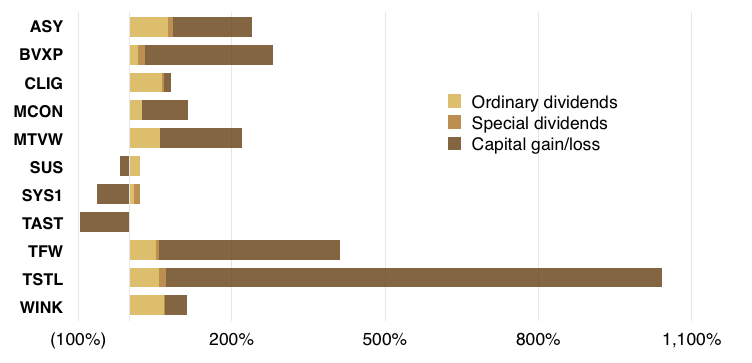
Just City of London Investment has returned far more in dividends (at least for me) than capital gains. My losses from S&U and System1 have meanwhile been offset to varying degrees by payouts.
Dividends have been the icing on the capital-gains cake for all my other shares. Going on these figures, perhaps the aforementioned lack of interest in income investing is not that surprising.
Still, capital gains do fluctuate while dividends can often provide greater stability (pandemics aside). Maybe one day ‘high-yield investing’ will regain its popularity if/when growth stocks begin to falter.
This final chart shows the trailing yields I currently enjoy based on my initial purchase cost:
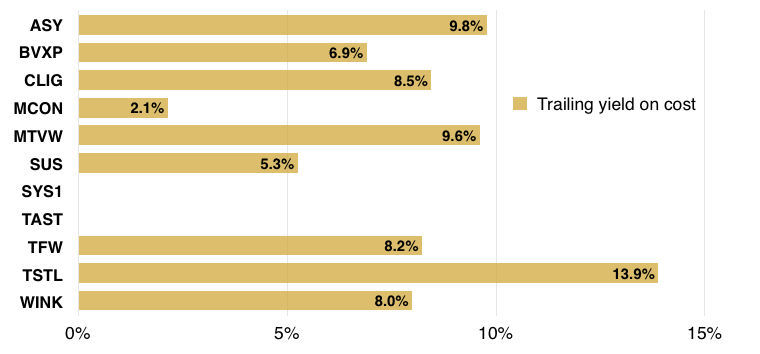
Six of my shares have lifted their dividends to supply yields-on-cost of 8% or more.
Dividends of course are not guaranteed, as developments at System1 (payouts cancelled for the foreseeable), Mincon (payout suspended, hopefully temporarily) and S&U (latest payout reduced by 35%) testify. But I am satisfied with my portfolio’s overall payout progress so far.
Until next time, I wish you safe and healthy investing.
Maynard Paton
PS: You can receive my blog posts through an occasional email newsletter. Click here for details.

